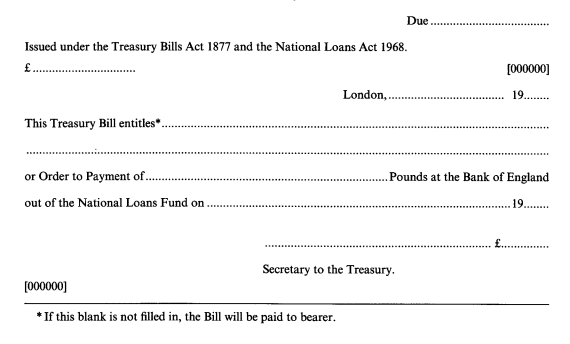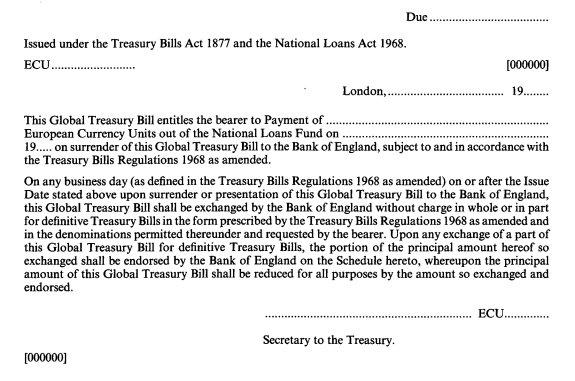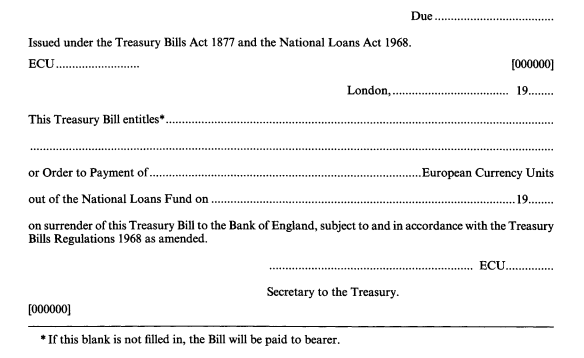Statutory Instruments
1988 No. 1603
EXCHEQUER
The Treasury Bills (Amendment) Regulations 1988
Made
15th September 1988
Laid before Parliament
19th September 1988
Coming into force
3rd October 1988
1. These Regulations may be cited as the Treasury Bills (Amendment) Regulations 1988 and shall come into force on 3rd October 1988.
2. The Treasury Bills Regulations 1968((3)) shall be amended as follows:
(a)in regulation 2(1), for the words “in the London Gazette” there shall be substituted “published in the London Gazette or by such other means as the Treasury may direct”;
(b)for regulation 3 there shall be substituted—
“3. A Treasury bill—
(a)if denominated in sterling, shall be in the form set out in Part 1 of Schedule 1 to these Regulations and, if denominated in ECU, shall be in the form set out in Part 2 or Part 3 of Schedule 1;
(b)shall have printed on it a facsimile of the signature of one of the Secretaries to the Treasury for the time being; and
(c)shall have printed on it the serial number of the bill.”;
(c)in regulation 4(1), for the words “denominations of £5,000 or multiples thereof as may be necessary” there shall be substituted “such denominations as are specified in the warrant”;
(d)in regulation 6(1), after the words “Treasury bill” there shall be inserted the words “denominated in sterling”;
(e)after regulation 6(1), there shall be inserted the following paragraphs—
“(1A) The principal sum payable in respect of a Treasury bill denominated in ECU shall, subject to paragraph (1B) of this regulation, be paid in ECU by credit or transfer to an ECU account nominated by the payee or, if the Bank of England determines that it has not been furnished with sufficient particulars of such an account, or has not been furnished with such particulars in sufficient time, to enable the credit or transfer to be made on the date of payment of the bill, be paid in ECU by banker’s draft at the head office of the Bank of England.
(1B) If the ECU ceases to be the unit of account in which the operations of the European Monetary Co-operation Fund are expressed pursuant to Council Regulation (EEC) No. 3180/78((4)), or any Council regulation amending or replacing the same, the principal sum payable in respect of a Treasury bill denominated in ECU
(a)shall be paid in ECU by credit or transfer to an ECU account nominated by the payee or, if the Bank of England determines that it has not been furnished with sufficient particulars of such an account, or has not been furnished with such particulars in sufficient time, to enable the credit or transfer to be made on the date of payment of the bill, be paid in ECU by banker’s draft at the head office of the Bank of England, or
(b)if
(i)the holder for the time being of the bill has notified the Bank of England in writing not later than seven days before the date of payment of the bill that he wishes payment to be made in the currency chosen in accordance with paragraph (1C) of this regulation by the Bank of England (“the chosen currency”), or
(ii)the Bank of England has determined that it would not be practicable for payments in ECU to be made in respect of Treasury bills denominated in ECU and has given notice of that determination not later than seven days before the date of payment of the bill in the London Gazette or by such other means as the Treasury may direct,
shall be paid in the chosen currency by credit or transfer to an account in the chosen currency nominated by the payee or, if the Bank of England determines that it has not been furnished with sufficient particulars of such an account, or has not been furnished with such particulars in sufficient time, to enable the credit or transfer to be made on the date of payment of the bill, be paid in the chosen currency by banker’s draft at the head office of the Bank of England.
(1C) The chosen currency shall be the currency chosen by the Bank of England on the first day on which the Bank of England is open for business following the day on which the ECU ceases to be the unit of account in which the operations of the European Monetary Co-operation Fund are expressed and shall be either United States dollars or a currency which is a component of the ECU, and the Bank of England shall, as soon as practicable after making such choice, give notice of the chosen currency in the London Gazette or by such other means as the Treasury may direct.
(1D) The amount of any payment due under paragraph (1B)(b) shall be calculated by the Bank of England on the following basis—
(a)by aggregating the United States dollar equivalents of the currency amounts which were the components of the ECU on the day on which ECU was last used as a unit of account in which the operations of the European Monetary Co-operation Fund were expressed pursuant to Council Regulation (EEC) No. 3180/78, or any Council regulation amending or replacing the same, and,
(b)if the chosen currency is a currency other than United States dollars, by calculating the equivalent in the chosen currency of such aggregate amount in United States dollars,
and in this regulation the United States dollar equivalent of any currency and the equivalent in any currency of an amount in United States dollars shall be determined by the Bank of England on the basis of the middle spot delivery quotations prevailing at noon London time in the London foreign exchange market two days (being days on which the Bank of England is open for business) before the date of maturity of the bill concerned, as obtained by the Bank of England from one or more banks in London selected by it.
(1E) All calculations and determinations made, the choice of any currency and the selection of any bank by the Bank of England under this regulation shall be at its sole discretion and shall in the absence of manifest error be conclusive for all purposes of this regulation and binding on the Treasury and the holders for the time being of the Treasury bills concerned.
(1F) If any day on which a payment is due in respect of any Treasury bill denominated in ECU is not a business day, the person entitled to payment shall not be so entitled until the next following business day, and in this regulation “business day” means a day on which banks in London and in the place where the account (if any) nominated by the payee is held are open for business and carry out transactions in ECU or, if any payment is to be made in the chosen currency, in the chosen currency.
(1G) If, but for this paragraph, the date mentioned in a Treasury bill denominated in ECU for payment of the principal sum mentioned therein would be more than twelve months from the date of the bill, the said date for the payment of the principal sum shall be the last day on which the Bank of England is open for business in the period of twelve months from the date of the bill.”;
(f)after regulation 9, the following regulation shall be inserted—
“(9A) In these Regulations “ECU” means the European Currency Unit as defined in article 1 of Council Regulation (EEC) No. 3180/78 or any Council regulation amending or replacing the same.”;
(g)for Schedule 1, there shall be substituted—
Regulation 3.
“SCHEDULE 1
PART 1
PART 2
SCHEDULEexchanges for definitive treasury bills
The following exchanges of a part of this Global Treasury Bill for definitive Treasury Bills have been made:
PART 3
Alan Howarth
Nigel Lawson
Two of the Lords Commissioners of Her Majesty’s Treasury
15th September 1988
Explanatory Note
(This note is not part of the Regulations)
These Regulations amend the Treasury Bills Regulations 1968. Regulation 2 is amended to enable an invitation to tender for Treasury bills to be published by means other than the London Gazette. Regulation 3 and Schedule 1 are amended to set out the form of Treasury bills denominated in ECU. Regulation 4 is amended to provide that Treasury bills will be prepared in the denominations specified in the warrant issued by the Treasury. Regulation 6 is amended to describe how payment is to be made where a bill is denominated in ECU. Payment will be made in ECU except that, if the ECU is not the unit of account in which the operations of the European Monetary Co-operation Fund are expressed, payment will be made in a currency chosen by the Bank of England if the holder of the bill so elects or the Bank of England determines that it would not be practicable for payments to be made in ECU. The regulation specifies the currencies that can be chosen and how the amount of the payment in the chosen currency is to be computed. A new regulation 9A is inserted defining the ECU.
1877 c. 2; section 9 was amended by Part XII of Schedule 1 to the Statute Law (Repeals) Act (c.12).
1889 c. 6; section 5 was amended by the Schedule to the Statute Law Revision Act 1908 (c. 49) and the Schedule to the Statute Law Revision Act 1966 (c. 5).
S.I. 1968/414.
Article 1 of Council Regulation (EEC) No. 3180/78 was amended by article 1 Council Regulation (EEC) 2626/84.



